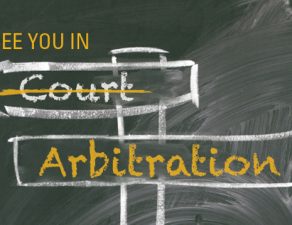Earlier this week month I blogged on whether Justin Bieber and a photographer, who were embroiled in a law suit in Florida over an alleged assault on the photographer, should submit their dispute to non-binding arbitration [short answer: yes!]. After describing how this form of alternative dispute resolution (“ADR”) worked, I promised to cover other hybrid forms of ADR in a future blog post. The future, dear readers, has arrived.
A Brief Review
Let’s review some basic definitions:
Arbitration: an agreement in writing to submit an existing or future dispute to an arbitrator for final and binding resolution. The Federal Arbitration Act, 9 U.S.C §§ 1 et seq., as well as state arbitration laws, provide for very limited court review of arbitration decisions, rendering arbitration awards essentially “final and binding.”
Mediation: an agreement, not necessarily in writing, to submit an existing or future dispute to a third party (the mediator), who will work with the parties to help them reach a settlement. The mediator cannot impose a settlement on the parties.
Non-binding arbitration: a process that looks and smells like a regular binding arbitration, but the arbitrator’s decision is not binding. Parties make opening statements, present evidence, and the arbitrator makes a decision. But, by prior party agreement the decision is not final or binding. The theory is that, after going through the full-blown process and seeing how an impartial arbitrator would decide the case, the parties will be more inclined to settle.
What are the Other Types of ADR?
While there are virtually limitless forms of hybrid ADR forms, I cover below just some of the major variations. In my mind, these alternate forms of ADR fall into three major groups: 1) arbitration variations; 2) mediation variations; and 3) what I call potpourri. Note that there are variations on the variations; I cover just the basics. In each instance, I cover what it is, the theory behind it; and why parties would use it.
Arbitration Variations
Described below are just a few hybrid forms of ADR that have as their core component arbitration.
Non-binding or Advisory Arbitration: covered briefly above and in the Bieber blog post.
Last Best Offer (a.k.a. “Baseball”) Arbitration: this one should look familiar to major league baseball fans. Here, the parties negotiate to their last and best offer (in the case of major league baseball, player’s last demand and team’s last offer). The arbitrator hears the case, and can only go with one figure or the other, nothing in between. There are no opinions. For example, if the player’s last demand is $15,000,000 and the team’s last offer is $10,000,000, the arbitrator must take either figure but not something more, less, or in between. In other words, the award is either $15,000,000 or $10,000,000. Knowing that the arbitrator can only pick one figure or the other, the parties will negotiate in good faith and settle many cases. In fact, in 2013, 100% of MLB salary arbitration cases settled, for the first time. This process is quick, promotes settlement, the parties have a certain level of control regarding outcomes, and the case will end either by settlement or arbitrator’s decision.
High-low (a.k.a. “Control Contract”) Arbitration: the parties negotiate to their last and best offer. The arbitrator hears the case and can award a figure at or between the parties’ two figures. In our example directly above, the arbitrator can award any amount between $10,000,000 and $15,000,000. That takes out of the last-best offer process a bit of uncertainty and risk, and gives the parties more control regarding outcomes. Its benefits are similar to last best offer arbitration.
Arbitration-Mediation (a.k.a. “Arb-Med”): the parties have a regular arbitration. By prior agreement, the award is not released for a prescribed time period, during which the parties attempt to settle their dispute by mediation (generally not the same individual who served as arbitrator). Counsel and the parties – including decision making executives – having participated in the case and having been exposed to other side’s strengths and their own weaknesses, and with the prospect of a final and binding decision is looming, will be more inclined to settle. This one is kind of like Deal or No Deal. Parties use this form of ADR primarily because a mediated settlement (80-85% probability) beats an imposed decision any time. A key question is whether the arbitrator is asked to don a mediator’s hat. While this can certainly save time and is very efficient, the arbitrator-turned-mediator obviously knows how the arbitration award will come out!
Arbitration-Negotiation (a.k.a. “Arb-Neg”): As in Arb-Med, the parties have a regular arbitration and by prior agreement, the award is not released for a prescribed time period. Here, however, instead of mediating the parties instead attempt to settle by direct negotiation. The same benefits generally apply, except that the parties rely on themselves to negotiate without the assistance of a mediator.
Mediation Variations
We now take a look at a few hybrid forms of ADR that has as their predominant component mediation.
Mediation-Arbitration (a.k.a. “Med-Arb”): this one is the mirror image of Arb-Med. Here, the parties have a mediation. By prior agreement, if mediation does not produce a settlement within a prescribed time frame, the case moves on to an arbitration phase, typically (but not always) before the same individual. The thinking here is that the parties will mediate intensely and in good faith knowing the risk of a final and binding decision is hanging over their collective heads. There is a high likelihood of settlement, plus all of the other benefits of mediation. Also, unlike mediation, there’s a guarantee of some final resolution irrespective of whether the case settles in mediation. The case will end one way or the other. The major drawback with Med-Arb before the same neutral is the risk that arbitrator will be influenced by information learned in the mediation phase – coupled with possible chilling effect of the parties holding back on admissions and such during caucuses because the know knowing the mediator might later be their arbitrator.
Mediation and Last Offer Arbitration (a.k.a. “MEDALOA”): as the name implies, the parties have a mediation. If mediation does not produce a settlement within a prescribed time frame, by prior party agreement, the case moves on to a “last offer” arbitration phase, typically before the same individual. The theory is that the parties will mediate intensely and in good faith knowing the sword of a final and binding decision is hanging over their collective heads (perhaps even more so, because it is “last-offer” type arbitration). There is a high likelihood of settlement, plus all of the other benefits of mediation and last offer arbitration. Also, unlike plain mediation, there is a guarantee of some final resolution irrespective of whether the case settles in mediation. I attribute the creation of MEDALOA to Robert Coulson, who had a long and distinguished career as president of the American Arbitration Association before retiring in 1994.1
Shadow Mediation: In this type of ADR, the parties have a negotiation or arbitration (or even litigation). A mediator is present but does not participate. At some juncture, the mediator then works with the parties to attempt to move toward settlement. It operates similar to Arb-Med in that the parties get to move well into the case, and then have a neutral, who has also seen and heard everything step in.
Appellate Mediation: this one is in many respects like Arb-Med. After the completion of a trial in a court of original jurisdiction, an appeal is filed. While the appeal is pending, the parties attempt to mediate. Like Arb-Med, the parties get to move well into the case, and then have a neutral, who has also seen and heard everything, come on board to help the parties settle. This process goes a step further in that the judge/jury has already rendered a verdict. Appellate Mediation boasts all of mediation’s benefits, which of course includes a very high likelihood of settlement. Also, there’s no real loss of time, given appellate court calendars.
Potpourri
Last, we review some hybrid ADR types that are not really dominated either by arbitration or mediation.
Fact-finding: as the name implies, a neutral is asked to find the facts in a tightly defined area. In theory, once the facts are determined, the parties will then work out a settlement. For example, a fact-finder might be brought in by the parties to issue a report on an allegation of sexual harassment. Usual, the fact-finder’s report is not binding and may or may not be admissible in subsequent adjudication (arbitration or litigation).
Early Neutral Evaluation: as the name implies, early in the litigation process – typically before discovery – an evaluator reviews the initial pleadings and recommends a settlement to the parties for the purpose of negotiations. The thinking is that having participated (counsel and parties – including decision making executives) the initial pleadings process, and having heard how a respected neutral might decide the case, the parties will be more inclined to settle. This can save time and money, since ENE is generally done before discovery. On the other hand, ENE being done so early, parties may be reluctant to settle before they have done discovery. Several federal courts have mandatory ENE programs for many civil cases.
Mini-Trial: as the name implies, the parties, with key executive decision makers present, conduct a summary trial – usually before a retired judge or other respected neutral. At the conclusion, the mini-trail judge renders an advisory opinion. Parties then negotiate directly, after being exposed to all facets of the case and seeing how the judge would decide the case. This is the litigation version of Arb-Neg.
Summary Jury Trial: this is pretty much the same as a mini-trial, but instead of a mini-trial judge, the case is heard by a jury, usually in court.
Complete Online Dispute Resolution (a/k/a “C-ODR”): a disruptive innovation in the ADR and legal areas that allows for accurate, efficient and affordable dispute resolution services process completely via the Cloud. This was pioneered by Arbitration Resolution Services.
The Ultimate in Hybrid ADR
I leave the best for last. In Avista Management v. Wausau Ins. Co., 2006 WL 1562246 (D. Fla. 2006), judge Presnell ordered that a discovery dispute be resolved by a game of “rock, paper, scissors.” Like all the ADR forms discussed in this blog post, this one was fast and effective!
1 I was a senior officer at the time and distinctly remember Bob proposing MEDALOA. Although in my youthful mind I thought this wasn’t a particularly good idea, history has shown he was correct.






